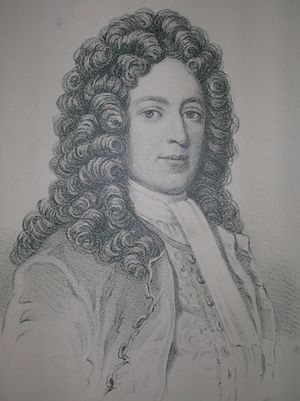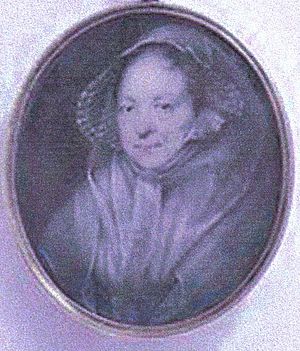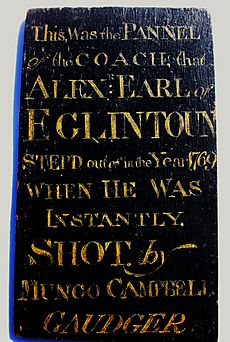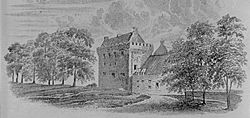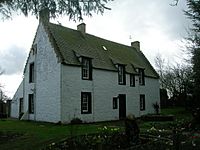Susanna Montgomerie, Countess of Eglinton facts for kids
Quick facts for kids
The Countess of Eglinton
|
|
|---|---|
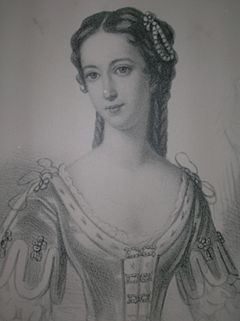
Lady Eglinton
|
|
| Full name |
Susanna Kennedy
|
| Born | 1 January 1690 Culzean Castle |
| Died | 18 March 1780 (aged 90) Auchans Castle |
| Buried | Kilwinning |
| Noble family | Kennedy |
| Spouse(s) | |
| Issue More |
3 sons and 8 daughters
James, Lord Montgomerie
Alexander, 10th Earl of Eglinton Archibald, 11th Earl of Eglinton Lady Elizabeth Montgomerie Lady Helen Montgomerie Lady Susan Montgomerie Lady Margaret Montgomerie Lady Christian Montgomerie Lady Charlotte Montgomerie Lady Grace Montgomerie Lady Frances Montgomerie |
| Father | Sir Archibald Kennedy, 1st Bt. |
| Mother | Hon. Elizabeth Leslie |
Susanna Montgomerie, Countess of Eglinton (born 1690, died 1780) was a very intelligent and well-known Scottish noblewoman. She was the third wife of Alexander Montgomerie, 9th Earl of Eglinton. Susanna lived for over 50 years after her husband passed away. She died at Auchans, Scotland in 1780, when she was 90 years old. She often signed her name as S. Eglintoune.
Contents
Early Life and Family
Susanna was born at Culzean Castle in 1690. Her father was Sir Archibald Kennedy, who was the first Baronet of Culzean. Her mother was Elizabeth Leslie, whose father was David Leslie, 1st Lord Newark.
A Remarkable Lady: Her Qualities and Marriage
Lady Eglinton was famous for her beauty and her height, as she was 6 feet tall. This was very unusual for women at that time. She was also known for supporting Scottish poets and writers. Susanna was incredibly smart and knew a lot about art, music, books, science, philosophy, and history. She could even speak Italian, French, and German. People thought it was quite odd for a lady of her high social standing to be so interested in literature.
Sir William Fraser, a Scottish historian, once said that "to her loveliness were added the more valuable attractions of genius and great accomplishment." This means she was not just beautiful but also very talented and smart.
Her Unusual Courtship
When Susanna arrived in Edinburgh around 1702, many men wanted to marry her. One man, Sir John Clerk, seemed like the most likely choice, but Susanna chose someone else. She married the 9th Earl of Eglinton in June 1709.
There's a story that the Earl had been interested in Susanna for a long time. His second wife was very ill, and when Susanna's father asked him about marrying Susanna, the Earl supposedly said, "Wait a bit, Sir Archie, my wife’s very sickly." Soon after, his second wife passed away, and he married Susanna.
Another tale says that Susanna was meant to marry the Earl. One day, while she was walking at Culzean, a hawk belonging to the Earl landed on her shoulder. People saw this as a sign, especially when they noticed the Earl's name on the silver bells around the hawk's neck.
Life as a Countess and Widow
Susanna was married for 20 years. She became a widow at the age of 40 and lived for another 51 years. She was known for her graceful way of walking, which people called 'the Eglinton air'.
Many famous writers and poets admired Lady Eglinton. Allan Ramsay dedicated his famous poem, The Gentle Shepherd, to her in 1725. Another poet, Hamilton of Bangour, wrote beautiful verses about Susanna and her daughters. Ramsay praised her "penetration, superior wit and sound judgement," saying she was also kind and calm.
Susanna even met King George II in 1730, and the Queen, Caroline of Ansbach, noticed her. King George II called her "the most beautiful woman in my dominions." Lady Eglinton hosted amazing parties that were rarely matched by others. However, she refused to attend the coronation of King George III in 1760 because she supported the Jacobite cause, which meant she favored the old royal family.
Her Secret to Beauty
Susanna kept her youthful looks until she died. People said it was because she never used makeup. Instead, she washed her face daily with sow's milk and drank it, recommending it to others. Her blue eyes, however, became lighter over the years.
Once, she playfully asked her daughter, Lady Bettie, "What would you give to be as pretty as I am?" Lady Bettie cleverly replied, "Not half as much as you would give to be as young as I am." People believed Susanna had found the secret to staying young, as her beauty seemed to last even into her sixties.
When Susanna and her daughters visited Edinburgh, the local guides were amazed by their beauty as they stepped out of their sedan chairs. A portrait of Lady Eglinton when she was young is still at Culzean Castle.
Involvement in Industry
The Montgomerie family owned several coal mines. Susanna was involved in overseeing the miners on their estate. Her letters show that she even helped resolve disagreements about working conditions in 1749–50. The miners felt they had to work 14 hours a day, six days a week, just to earn enough money.
Susanna called the miners to Eglinton Castle to try and fix the problems. A lawyer involved in the case noted that "a Lady of great Beauty of Address might prevail with some of the old Coalziers to sign any paper."
She was very hardworking and even started a distillery, which later became a brewery. This was located in Montgomeryston, near Ayr, and helped increase her income, though it was only moderately successful.
Her Children and Stepchildren
Susanna had three sons:
- James, Lord Montgomerie, who died young.
- Alexander, who became the 10th Earl of Eglinton.
- Archibald, who became the 11th Earl of Eglinton.
She also had eight daughters, most of whom married:
- Lady Elizabeth married Sir John Cunningham.
- Lady Helen married Francis Stuart.
- Lady Susan married John Renton.
- Lady Margaret married Sir Alexander MacDonald.
- Lady Christian married James Moray.
- Lady Grace married Cornet Byrne in 1751 and died that same year.
- Lady Frances died without marrying.
- Lady Charlotte died suddenly from a fever.
- Lady Eleanor was often unwell, and trips to Bath did not help her.
- Lady Susanna died from scurvy.
Their mother's elegant way of walking, the "Eglinton air," was passed down to her daughters. Susanna also had seven stepchildren from her husband's previous marriages.
Two of her sons had smallpox, and one had scarlet fever. All her daughters, except Charlotte, lived long enough to marry and have children. However, Susanna outlived all of them.
Lady Margaret MacDonald helped Flora MacDonald in her efforts to save Bonnie Prince Charlie, a historical figure, while her husband was away fighting.
The Tragic Death of Her Son Alexander
On October 24, 1769, near Ardrossan, Susanna's son, Alexander, was traveling in his carriage. He met two men, one of whom was Mungo Campbell. Alexander had previously caught Mungo hunting on his land without permission. Alexander asked Mungo to hand over his gun, but Mungo refused, saying he would rather die. In the struggle that followed, Mungo shot Lord Eglinton. Alexander was badly wounded and died ten hours later at Eglinton Castle.
Susanna was deeply saddened by the sight of her dying son being carried into the castle. She wrote, "I shall endeavour to bear my suffering with as little trouble to my fellow creatures as possible." After this tragic event, she mostly withdrew from public life. Mungo Campbell was tried and sentenced to death, but he died in prison before his execution.
Many of the estate tenants felt more sympathy for Mungo Campbell than for the Earl. They saw the Earl's death as a punishment from heaven because he had made changes to old customs and interfered with old tenants. Mungo himself was well-liked in the areas where he worked.
Since Alexander died without marrying, his brother, Archibald, became the next Earl. The carriage door, which had details of the tragedy, was kept by the Montgomerie family for many years. This event was even written into a novel by John Galt, called Annals of the Parish.
Her Homes as a Dowager Countess
It was a common practice for a dowager (a widow of a noble) to move out of the main family home and live in a smaller house called a dower house. Susanna first moved to Kilmaurs Place in East Ayrshire. Later, she moved to Auchans near Dundonald. Letters from 1751 to 1762 show her writing from Kilmaurs, and from 1765, she wrote from Auchans. In 1762, she wrote that her son (the tenth Earl) had given her Auchans House, and she was planning to repair it. When her second son, Archibald, married in 1772, she lived permanently at Auchans for eight years.
Views of Auchans House
Meeting with Famous Writers
In 1773, famous writers James Boswell and Samuel Johnson visited Lady Susanna at her home, Auchans. Her son Alexander had already told his mother a lot about Johnson.
Susanna knew that Johnson wanted to live a long life and became upset if death was mentioned. When they were leaving, she politely hugged Johnson and said that since she was old enough to be his mother, she would adopt him as her son. Johnson was very happy about this. Auchans is now a historic ruin.
Lady Susanna is also remembered for taming rats at Auchans. She would tap on an oak wall panel and open a small door, and ten or twelve rats would come for food at her table. They would leave when she told them to. She said she valued the gratitude they showed, which she rarely received from humans.
Samuel Johnson later wrote that Susanna was "a lady who for many years gave the laws of elegance to Scotland." He also described her as having a "majestic" appearance, "high bred" manners, "extensive" reading, and "elegant" conversation.
See also



